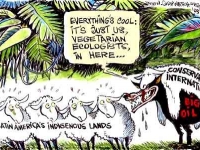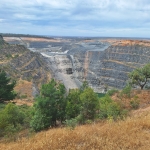Conservation at All Costs
How Industry-Backed Environmentalism Creates Violent Conflict Among Indigenous Peoples

Inside the two room mud house there is shade from the relentless equatorial sun. Ekufa Muwesha, the embattled Wai Wai chief-or Toshao-of Parabara Landing, reclines gracefully in a double-weave hammock, one leg dangling over the side as he gently sways. At times he talks so quietly I have to strain to hear him, but the softness in his voice does nothing to diminish the weight of his words. "This may start a war if the protected area is established," Ekufa explains.
In the summer of 2002, Toshao Ekufa met secretly with Washington-based Conservation International and signed his name to a controversial letter requesting that Parabara become the northernmost border of the proposed Southern Guyana Protected Area. This appeal, intended to signal the consent of the region's Amerindian tribes to the Guyanese government's conservation process, triggered the announcement that Conservation International would serve as the so-called management authority during the creation of a protected area the size of New Jersey.
But instead of confirming Amerindian consent, the announcement provoked heated opposition among local village leaders and national Amerindian rights advocates, and a potentially violent response within Parabara. Dissenters argued that the region's second, more populous tribe, the Wapishana, were excluded when CI's CEO Peter Seligmann announced that "A key component of the [conservation] process would be involvement of stakeholders, including the Wai Wais," and that the informal consultation process that took place with the Wai Wai prior to the announcement had violated the Guyanese law which requires a majority vote of the village council prior to agreements affecting community lands.
Among Wapishanas living in Parabara the sense of betrayal was so profound that news of Ekufa's move raised cries not only for his dismissal as village leader, but for his head. One Wapishana proposed hoisting Ekufa's severed head on a pole in the center of the village, offering that "He can rule that way." Another villager suggested Ekufa's limbs be tied and his body cast into a canoe and floated downriver. Ekufa responded by threatening violence against Wapishanas.
Beyond this inter-tribal conflict, for people living in the remote region CI's singular focus on protected areas fails to address the more immediate fear that several industrial gold mines poised to begin production could potentially devastate the local rivers which serve as the basis for the local economic survival. Amerindians in Guyana are no strangers to cyanide disasters from gold mines: in the 1990s Guyana was the site of one of the world's worst-ever cyanide spills when a tailings dam operated by the Canadian company, Cambior, burst from overuse and spread cyanide across the country's central waterway.
"We don't have any problem with conservation," says Toshao Tony James, whose village near one of the mines would be devastated by cyanide pollution. "It's in our interest to learn how to conserve our resources properly. But why is it that when it comes to this mine that could destroy our communities and have us fighting each other like dogs for whatever's left, CI does nothing? Where are they when it counts?" Ironically, one look at a map shows that a spill into one of the area's rivers would bring cyanide directly into the proposed protected area.
Trouble in a Land of Plenty
Although it falls so far below the media radar most people assume it's in Africa, Guyana is one of few the remaining jewels in the scramble for tropical timber and mineral products. Located on the forgotten northern coast of South America, a single rutted road pierces a hinterland which remains eighty-percent jungle. The country's highways are its rivers. Guyana's maze of riverways literally flows with golden water that wends through forests so abundant one word-plenty-quickens every conversation; rivers are filled with plenty piranha; there are plenty mosquitoes in the next village; a tarantula bite hurts plenty; streets are covered with plenty mango.
First settled by the Wapishana family of Henry Lawrence in the early 1980s, Parabara Landing, in southern Guyana, is a small village of 75 souls tucked into the jungle at the end of the battered road that connects the country's vast northern and southern rainforests. The Wai Wai and Wapishana live side-by-side in thatched-roof houses perched along the bank of the Kuyuwini River. Until recently, the two tribes coexisted in relative peace, sharing resources and political control, intermarrying freely, and even collaborating on their overlapping, unrecognized land claims to Parabara's watershed by teaching each other digital mapping techniques.
But to Wapishanas, Ekufa's newfound alliance with Conservation International also signaled a transformation in his willingness to share ownership rights between both tribes. "Since Conservation International, Ekufa started putting Wai Wais like this and Wapishanas like this," one villager says, pointing skyward for Wai Wais and down for Wapishanas. "That's why we don't want him as leader."
"Everything was fine, we had no problem accepting him as Toshao," says Lawrence, referring to the fact that Ekufa had been elected despite moving to Parabara less than five years ago. "But now," he trails off dejectedly, looking towards a banana tree next to his house.
For his part, Ekufa does or says little to dispel the notion that his perception of ownership rights has changed. As he slowly unravels his rationale for bypassing the village council before negotiating with CI, he repeatedly returns to idea that Wai Wai culture remains more intact, more authentically Amerindian, than Wapishana culture, and that this cultural authenticity gives the Wai Wai the only legitimate claim to the village. Finally, I ask Ekufa why he is now convinced, after living side-by-side with Wapishanas for years, even marrying a Wapishana, that the Wai Wai are the only tribe to have preserved their culture. "Major-General said so," he answers.
Major-General is Joe Singh, under whom Ekufa and other Wai Wais served while Singh was head of the Guyana Defense Forces. He is now Executive Director of Conservation International-Guyana, but among the Wai Wai Singh still commands the reverence reserved for a military leader. It was Singh who engineered the letter from Ekufa, and delivered it to the government. "Major-General said that we have to write the letter," Ekufa explains. "I told him, 'We don't know what to say, you have to write it'. So he told us what to say, and we wrote the letter."
This assertion, that it was Singh not the Wai Wai who initiated the letter, was also recorded by the elected District Chairman, Vincent Henry, who wrote in a letter to the government that "It was disturbing to find out that the letter to the President (edited by the villagers) was written by Major General Joe Singh." In the same letter, Henry protested that CI bypassed local democratic institutions in a series of undisclosed meetings with the Wai Wai which only later were explicitly defined as part of the protected areas process. "It seems that a deliberate effort was made to sideline the Regional Democratic Council in the whole matter," Henry wrote. "This, I must say, contributed in a great way to what is happening in Parabara."
When I spoke with Henry months later, he was still concerned about the tension in Parabara, saying despondently, "There were some problems before CI, but nothing like this."
Singh, however, maintains that at no point did CI drive the consultation process, insisting that "The Government of Guyanaled the process - not CI - and invited the participation of the advocacy groups." More to the point, CI rejects outright the suggestion that the conservation process resulted in any kind of serious conflict in Parabara. Acknowledging only that there was a disagreement between the Wai Wai and Wapishana, CI's Media Relations Manager in Washington, Brad Philips, called the suggestion that the inter-tribal conflict had escalated to the brink of violence "totally ludicrous."
Meanwhile, Singh contends that any conflict was settled by a government-led consultation team, which gained the support of Wapishana villagers after agreeing to relax the timetable on making the boundary of the protected area extend as far north as Parabara. "The Wai Wai and Wapishanas continue to live in harmony without any hint of conflict," Singh says.
Still, reports from sources who have visited the village as recently as November say the tribal conflict persists. "They don't know," the source says. "There is still a problem in there. They're out in Georgetown, they don't know what's going on here. It has become a bit more quiet since CI stopped concentrating on Parabara for a while, but CI created a division between Wai Wais and Wapishanas that won't be easy to mend, and I'm personally convinced that it will never be peaceful there again."
Divergent Interests
While conservationists have traditionally professed to sharing deep ideological bonds with indigenous peoples, in fact the two movements have diverged sharply in the last decade when it comes to the issue of indigenous land and resource rights. The conservation paradigm applied by Conservation International is the "hot spot" approach, an idea attributed to British ecologist Norman Myers, which proposes that 44 percent of all species of vascular plants and 35 percent of vertebrates are concentrated on just 1.4 percent of Earth's land surface. By targeting 25 essential "hot spots," in a kind of triage approach to saving global biodiversity, Conservation International believes it can effectively defy the end of nature.
The upside of this approach is that it may save many of the world's endangered species. The downside is that it passes no moral judgment on what happens to the other 98.6 percent of the planet. As a result, the conservation movement, unlike other environmental campaigns, has actually increased its wealth and influence over the last decade. Because saving hot spots does not pose a fundamental threat to fossil fuel and other extractive industries the way the climate change movement appeared poised to do in the early- and mid-1990s, the conservation movement has increasingly moved toward alliances with industry. Leading conservationist agencies are frequently willing to enter into customary agreements with the oil and mining sectors, endorsing new gas pipelines in Peru, Cameroon, and Ecuador, and pushing only for "responsible mining practices" in places where high biodiversity and weak environmental enforcement power generally go hand-in-hand.
These alliances have allowed CI, and groups like it, to amass significant fortunes. Though CI is not yet close to the Nature Conservancy's three billion dollars in assets, by doing away with the expense of direct mail campaigns and relying on what it calls "committed, informed, individual and corporate partners," CI has accrued nearly $300 million in just 15 years, and recently set its sight on raising six billion dollars by decade's end. These partners include ExxonMobile, Macdonald's, Intel, Citigroup, Ford, and other corporations. Although CI's tax records and annual report do not reveal the names of and awards made by specific donors, some of its bigger gifts have become public, in particular a $261 million donation from the Moore Foundation, the philanthropy started by Intel founder and CI's Chairman Gordon Moore.
While CI maintains that industry alliances do not compromise its commitment to working collaboratively with local communities, some environmental groups remain critical of the method. "CI's approach is based on an argument that the interests of some communities may just have to be sacrificed for the greater good of conservation," says anthropologist Catherine Coumans of Mining Watch Canada. "Some NGOs, CI being one, have reached a level of clout where they've managed to get the leverage they need to make corporations and governments pay attention to them. But in their zeal to use this power to achieve their own narrowly defined goals they've become executors of industry."
Neutrality in Question
Indeed, when it come to dealing with land claims the hot spot paradigm is problematic: not only does the possibility of recognizing the land and resource rights of indigenous peoples pose a potential threat to a state's ability to finance itself through mineral and timber concessions, but land claims can easily stick a pin into conservation progress. Fifty-percent of all protected areas worldwide are on indigenous lands.
Officially, CI remains neutral on the issue of land claims, arguing that its scientific mission to preserve threatened ecosystems contains no implicit obligation to see that ancestral land claims are resolved alongside the conservation process. "We do not play a role in determining land tenure issues," Singh says. Yet, indigenous rights advocates say that because of the type of resources and influence conservationists wield with national governments, their activities in developing countries frequently lead to situations where communities are left little choice but to accept the establishment of protected areas on ancestral lands.
"Conservation management systems often take no account of indigenous peoples' knowledge and relationship to their territories," says Fergus MacKay, a human rights lawyer with the Forest Peoples Programme. "Indigenous peoples argue, with extensive support from international human rights and environmental treaties, that conservation activities must not be externally imposed, must respect their human rights, and must build upon their own management systems, MacKay says.
Because protected areas have consistently resulted in denial of resource-use rights for communities and in some cases forced resettlement-a trend which leads to economic impoverishment, cultural decline, and land conflicts-many indigenous activists are increasingly wary of large-scale conservation projects. More than once in Guyana, this has led indigenous groups to invoke human rights instruments to stall conservation projects and demand the settlement of land claims alongside the conservation process.
The capacity indigenous groups have to throw a wedge in conservation projects concerns CI officials who are determined to keep conservation investment flowing into the country. "Conservation without resources is just conversation," says Clayton Hall, Director of CI-Guyana, rehearsing a favorite theme.
Having watched Amerindians oppose the World Bank's conservation effort in Guyana in the late 1990s over human rights violations, a campaign which led the Bank to withdraw temporarily, Hall is adamant that land claims will not obstruct conservation progress this time. Walking to a map plastered on the wall next to a shelf filled with Amerindian crafts, Hall points to the Parabara Watershed and the overlapping Wai Wai-Wapishana land claims. A menacing tone enters his speech: "There is no anthropological evidence of any Wapishanas using this area," he declares. "This area belongs to the Taruma, who still live in the jungle uncontacted. We are protecting it for them because they cannot handle European diseases." Glaring, he almost shouts, "If the Wapishanas want to agitate, they will get nothing."
In his recent book "The Future of Life", CI board-member and intellectual figurehead, E.O. Wilson, praises the tireless altruism of conservation NGOs for trying, unlike corporations, "to steer clear of local government policy and political ideology. Their focus stays on their one driving reason for existence: the protection of biological diversity." But Hall's insertion of the Taruma as a wildcard is hard to square: The last members of the Taruma tribe died more than 50 years ago, and rumors of uncontacted tribes living in southern Guyana are unsubstantiated, even laughed at by experts. Despite its absurdity, the position appears deliberately ideological, aimed at rejecting the legitimacy of one tribe's land claim for the protection of a tribe that no longer even exists.
If Conservation has arrived at a position of power, it has in the process misplaced a deeper commitment to human rights and well-being, and forfeited the environmental movement's enduring challenge of restoring a deeper ecological freedom where human communities cohabitate with the natural world. Igniting intertribal conflict is a distressing byproduct of pursuing conservation at any cost: peace is not an acceptable price to pay for preservation.
Shefa Siegel is a freelance environmental writer who has worked with indigenous groups in Guyana and British Columbia.



